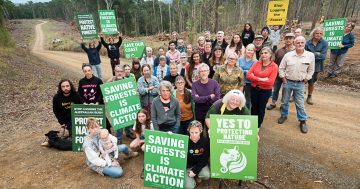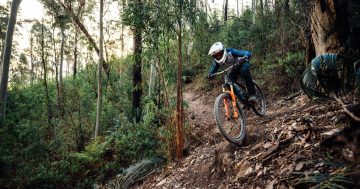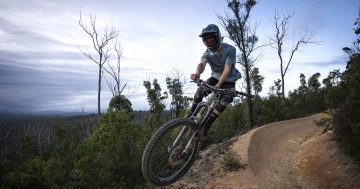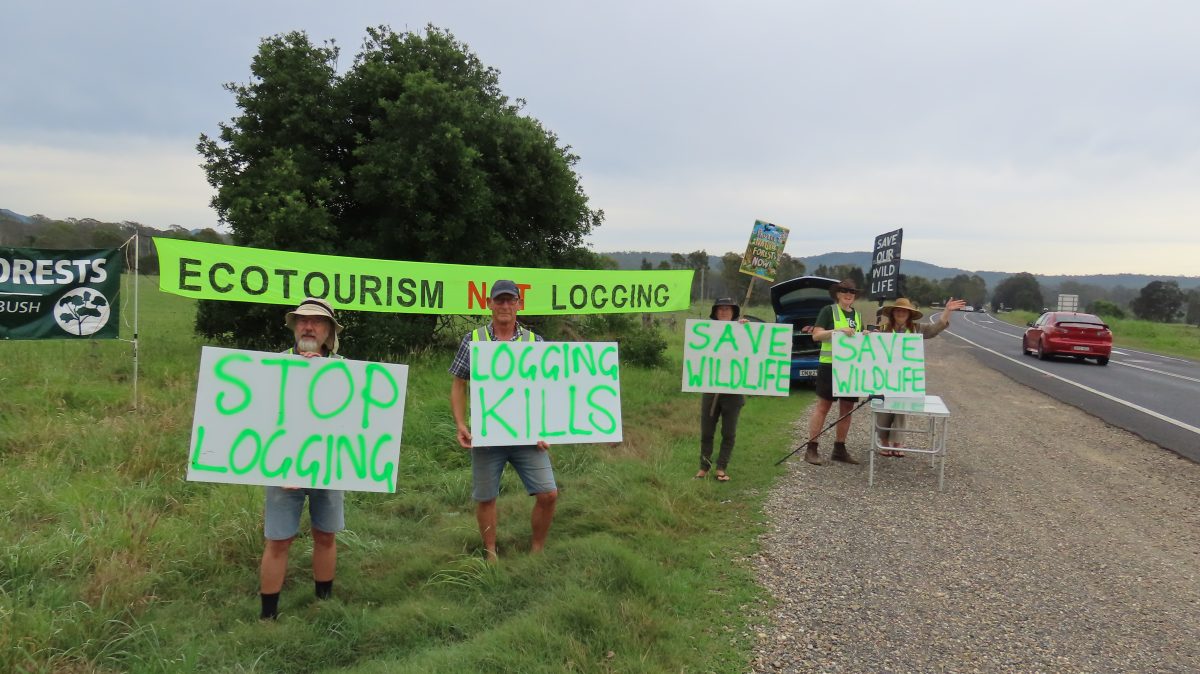
Friends of the Forest (Mogo) have been holding ‘Emergency Forest Embassies’ at the corner of Larrys Mountain Road and the Princes Highway since 26 November to protest logging. Photo: Supplied.
If logging ceased in the Eurobodalla, it would reduce the shire’s annual greenhouse gas (GHG) emissions by 246,000 tonnes. That would negate more than half of its yearly total emissions of 396,000 tonnes from electricity, transport, agriculture, waste and gas.
These were claims that Joslyn van der Moolen made to Eurobodalla Shire Council at the regular public access on 3 December. Councillor Anthony Mayne was an apology.
Ms van der Moolen was prompted to speak because logging at Mogo State Forest started two weeks ago. The Mogo State Forest operation of 534 hectares is part of 110,000 hectares of public state forest that covers 31 per cent of the Eurobodalla.
Her first point was that page 11 of the council’s Climate Action Plan 2022-2032 put total GHG emissions for the Eurobodalla local government area at an estimated 396,000 tonnes in 2019/20.
The main sources of emissions were electricity (67 per cent) and transport (26 per cent), with agriculture and waste each contributing 3 per cent. That figure did not include GHG emissions from land-use change and forestry.
Ms van der Moolen then cited ZeroSE’s fact sheet that estimated GHG emissions from logging in the Eurobodalla shire at 246,000 tonnes.
“If we stopped logging, more than half of our shire’s emissions would be negated,” Ms van der Moolen said.
She was speaking as a member of Coastwatchers Association’s Forest Working Group and as community liaison for Friends of the Forest (Mogo). The latter group has been holding ‘Emergency Forest Embassies’ on the corner of Larry Mountain’s Road and the Princes Highway since 26 November to protest about logging in the Mogo State Forest.
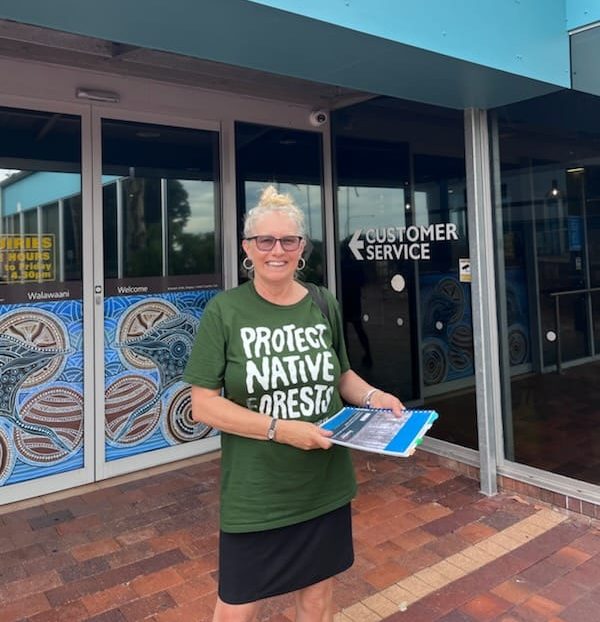
Joslyn van der Moolen outside Eurobodalla Shire Council building on 3 December to address councillors in the public access meeting. Photo: Supplied.
Ms van der Moolen next spoke of the need to protect the shire’s two new mountain bike trails from logging in the Mogo and Bodalla state forests.
The Mogo Bike Trails received $8 million in government funding and the Narooma Mountain Bike Hub in the Bodalla State Forest received $4.1 million. The funding for the two trails predominantly came from the Federal and NSW governments’ Bushfire Local Economic Recovery Fund.
A global mountain biking event, Sea Otter, will be held in Mogo next year, “yet these state forests aren’t protected from logging”, Ms van der Moolen said.
Ms van der Moolen said without protection from logging, the trails were at risk of being closed for months, and of being damaged. “To provide certainty for the industry, the forests must be protected for ecotourism and carbon capture.”
After her address, Councillor Mick Johnson asked what the logged trees were used for and where the timber came from for construction.
Ms van der Moolen said the majority of the logged trees became wood chips for export (35 per cent) and firewood (29 per cent). More than 80 per cent of timber for construction comes from pine plantations.
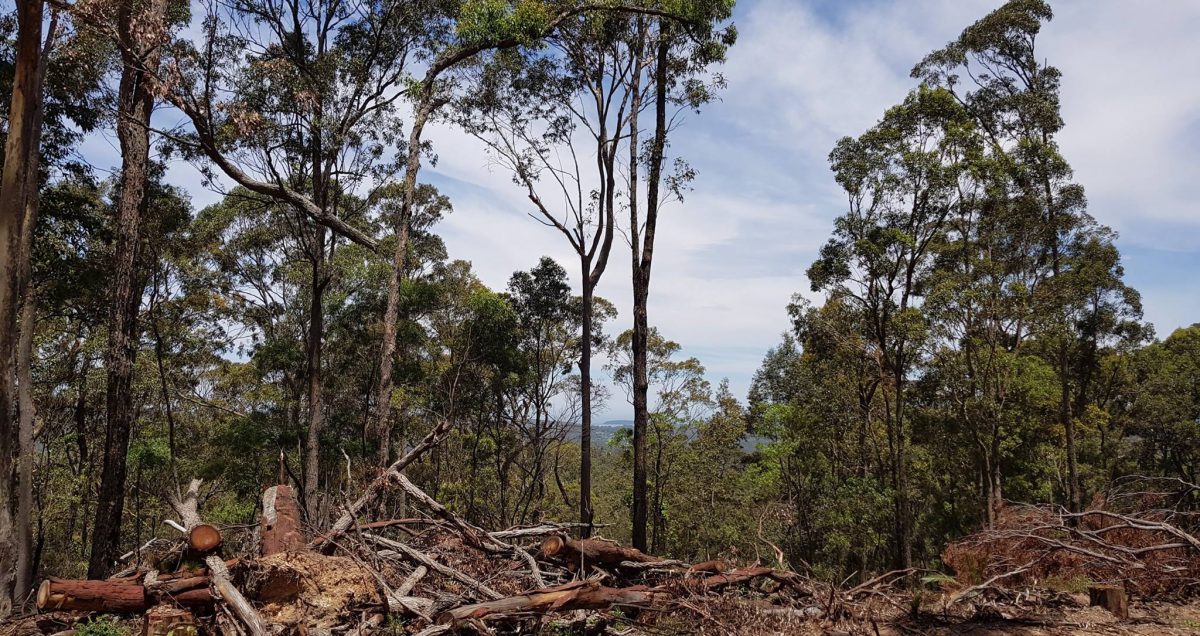
Logging in Mogo State Forest began two weeks ago. Photo: Friends of the Forest (Mogo) Facebook.
Councillor Coleen Turner (Greens) asked about the impact on native animals.
Ms van der Moolen responded that Coastwatchers had found 10 greater gliders in the forest and not all of them were in protected areas.
“It is a very beautiful forest, and more than half of the shire’s emissions can be negated if we stop logging,” she said.
“Council is a key stakeholder in the mountain bike trails. The trails will get damaged,” Ms van der Moolen said. “They should be put in a forest preserved area like there is around the Old Coach Road on the way to Big Spotty in Brooman State Forest. The big trees we see taken down are hundreds of years old.”
Fiona McCuaig, who was addressing the council about necessary upgrades to the Old Highway for her conservation burial site Walawaani Way, said she used to see one logging truck a day from her property in Bodalla. She said it was now six or seven trucks a day.
“It increases the fire risk to this community,” Ms McCuaig said.
The conservation burial site is being planted to bring back the endemic forest habitat for yellow-bellied gliders and glossy black cockatoos, as well as trees for koala habitat.
“We are logging the Bodalla State Forest where there are koalas,” Ms McCuaig said.







